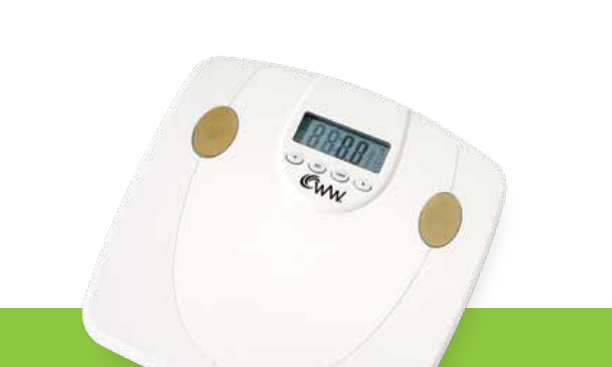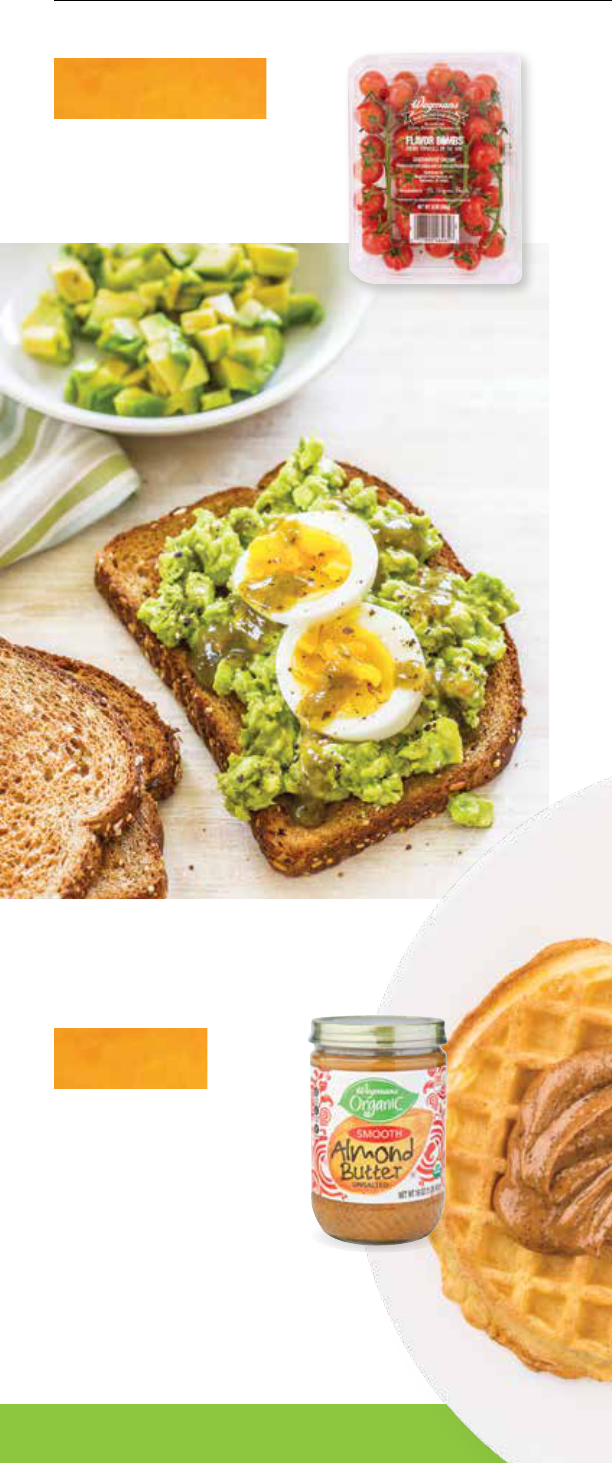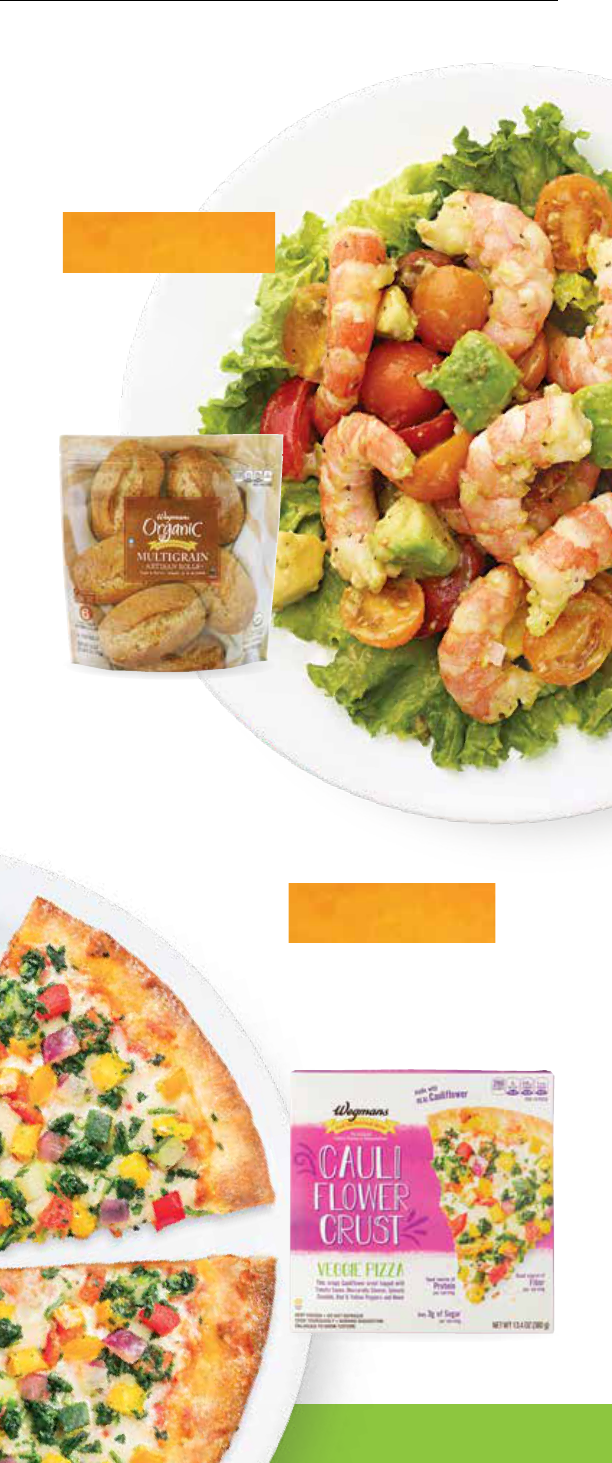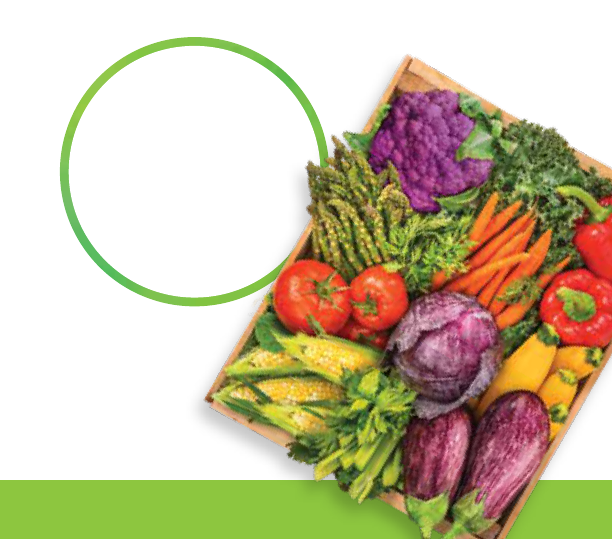
Living with
Type 2
Diabetes?
We can help!
Helping you live a healthier, better life

Contents
What is Type 2 Diabetes?...........................................3
Lifestyle Changes........................................................4
Building a Meal for Type 2 Diabetes...........................6
Meal Inspiration..........................................................8
Frequently Asked Questions.....................................14
How Wegmans Helps................................................16

What is Type 2 Diabetes?
Type 2 diabetes is a disorder where your body
is unable to use insulin properly. This can
cause elevated blood sugar and other health
complications.
34.2 million Americans—10.5 percent of the U.S.
population—have diabetes. Of those Americans,
1 out of every 4 doesn’t know they have diabetes.
There are two main types of diabetes—Type 1 and
Type 2. Type 2 diabetes is the most common type
of diabetes. Diabetes is serious and requires close
monitoring and maintenance. Although there is
no cure, you can still have a healthy and happy life
living with diabetes—and you play a vital role in
managing your disease.
A healthy lifestyle is a key in managing your
diabetes. Lifestyle changes can be very difficult
to make at first, but with support and a desire to
make them, they can become a new way of life for
you. Advice on managing your diabetes can come
from many different directions; our goal is to offer
support and help you decide what is right for you.
We are not here to substitute for your physician, but
we’d like to be another part of your diabetes team.
The rest is up to you!
3
Grilled Chicken
with Broccoli Florets
& Sweet Potatoes
Wegmans Pharmacy and Nutrition teams have based this booklet on the American
Diabetes Association (ADA) Standards of Diabetes Care 2019 and American
Association of Clinical Endocrinologists (AACE)/American College of Endocrinology
(ACE) Comprehensive Type 2 Diabetes Management Algorithm 2019.

4
Five lifestyle changes
that make a big difference
While there are many lifestyle habits that can aid in
managing diabetes, focusing on these five basics is a
great place to start.
1. Eat a healthy diet
There is no set diet for people with diabetes, but
there are some tips that may help you on the path
to healthy food choices. See the “Building a Meal
for Type 2 Diabetes” section on page 6.
2. Get moving!
Exercise, or physical activity, is one of the most
important ways to lower your blood sugar and
manage diabetes. Physical activity affects your
body in many ways; it not only lowers your blood
glucose and helps you lose weight, but also can
lower blood pressure, cholesterol, and the risk for
heart disease and stroke. Exercise can give you
more energy, lift your mood, and even help relieve
stress. It can include walking, swimming, hiking,
playing sports, doing yoga, gardening and even
housework to get you moving. Find what you enjoy
doing the most and go for it!
Although any physical activity is healthful, be
sure to check with your doctor to see what
kind of physical activity is best for you (and any
restrictions you may have). Gradually increase
your active minutes each day with activities such
as brisk walking and strength training to reach a
recommended 150 minutes of moderate intensity
physical activity per week. Start any new activity
slowly and increase intensity gradually.
3. Maintain a healthy weight
Maintaining a healthy weight not only lowers
blood sugar, but also lowers blood pressure
and cholesterol just as exercise does. If you are
overweight, exercise along with eating a healthy diet
are the keys to losing weight. It is important to have
ongoing support when trying to stay at a healthy
weight. If you are having trouble losing weight or
staying at a healthy weight, talk with your doctor or
a registered dietitian for more support.

5
4. Limit alcohol intake
For people with diabetes, there are risks
associated with drinking alcohol. Alcohol can lower
blood sugar which can cause hypoglycemia. It can
also interact with some medications, including
diabetes medications. If you drink alcohol, discuss
with your healthcare team how and when it may
be consumed to minimize these risks.
5. Set a quit date
If you are a smoker with diabetes, you are at a high
risk for having a heart attack or stroke. Quitting
smoking has major benefits to your health and
is the number one preventable cause of death.
If you smoke and would like to quit, talk to your
Wegmans pharmacist or your doctor about
different options we have to help.
You can lower your risk
for having Type 2 diabetes
by more than half with
moderate exercise & staying
at a healthy weight
Did you
know?

6
Building a Meal for
Type 2 Diabetes
Determining what, how much and when you eat
foods, especially foods that contain carbohydrates, is
important for managing Type 2 diabetes. Yet, there’s
no single “diabetic diet” that’s right for everyone.
The graphic below can help! Use this as a visual guide
to get started with what to put on your plate. Work
with your healthcare team to learn how much and
when to eat foods that will support your specific needs.
Non-
Starchy
Veggies
Grains or
Starchy
Veggies
Protein
Foods
• Non-Starchy Veggies: asparagus, beets, broccoli,
Brussels sprouts, carrots, cauliflower, celery,
cucumber, eggplant, jicama, leafy greens, onions,
mushrooms, radishes and tomatoes
• Protein Foods: seafood, poultry, meat, eggs, cheese,
nuts, seeds, beans and lentils
*
A few examples for each food category
* Beans and lentils are sometimes counted as starchy vegetables. Refer to the FAQ “Are beans and lentils starchy veggies or protein foods?” for more information.
**Choose whole grains more often than refined grains.
Fruit,
Milk or
Yogurt
Fill half of your plate with
non-starchy vegetables, one
quarter of your plate with
protein foods and one quarter
of your plate with grains
or starchy vegetables. One
serving of fruit, milk or yogurt
may also be added to a meal.

The American
Diabetes Association
has more information on
making food choices at
diabetes.org
Did you
know?
7
• Grains
**
or Starchy Veggies: bread, cereal, corn, pasta,
peas, potatoes, oats, rice, quinoa, corn, winter squash
• Fruit: apples, berries, cherries, grapes, peaches,
and oranges
• Milk: reduced-fat, low-fat and fat-free milk
• Yogurt: Greek or plain low-fat or fat-free yogurt
* Beans and lentils are sometimes counted as starchy vegetables. Refer to the FAQ “Are beans and lentils starchy veggies or protein foods?” for more information.
**Choose whole grains more often than refined grains.

8
Avocado Toast paired
with Flavor Bomb
Tomatoes
Organic Multigrain
Waffles with
Almond Butter &
Strawberries
Breakfast
non-starchy veggies,
protein, whole grains
protein, whole
grains, fruit

9
Eggs with
Spinach
& Carrots
paired with
Cantaloupe
Meal Inspiration
non-starchy
veggies,
protein, whole
grains, fruit

10
Greek Turkey Burger with
Fresh Cut Zucchini Sticks
Lunch
non-starchy veggies,
protein, grains

11
Shrimp
Salad with a
Multigrain
Roll
Cauliflower Crust
Veggie Pizza &
Arugula Salad
Meal Inspiration
non-starchy veggies,
protein, grains
non-starchy veggies,
protein, whole grains

12
EZ Meal Chicken
Parmesan with Broccoli
& Zucchini Noodles
Dinner
For recipes, nutrition
facts & more, visit
wegmans.com/
livingwithdiabetes
non-starchy veggies,
protein, grains

13
Chili Garlic
Fish with Tom
Tom Sauce
served with
Red Quinoa
Kung Pao Beef Stir Fry
served with Brown Rice
& Clementines
Meal Inspiration
non-starchy veggies,
protein, whole grains
non-starchy & starchy veggies,
protein, whole grains, fruit

14
Q: What types of foods and beverages
contain carbohydrates?
A: Fruits, vegetables, grains and grain products, milk and
milk products, beans, legumes, nuts and seeds contain
carbohydrates. Some contain more than others, for
example, starchy veggies contain more carbohydrates than
non-starchy veggies. Desserts and sweetened beverages
also contain carbohydrates but provide very little nutrition.
Choose carbohydrate foods that also provide vitamins,
minerals and fiber, like fruits, veggies, whole grains, milk
and milk products, beans, legumes, nuts and seeds.
Q: What are naturally occurring sugars
vs. added sugars?
A: Naturally occurring sugars are sugars that are naturally
present in foods such as fruits, vegetables, and unflavored
milk. Added sugars are sugars added during the processing
or preparation of foods, or at the table, like honey, agave
nectar, maple syrup and table sugar. Sometimes foods
have both, like blended fruit yogurt. Choose foods with
naturally occurring sugars more often as they also provide
vitamins, minerals and other nutrients.
Q: If carbohydrates raise blood sugar,
should I avoid eating them?
A: No! Carbohydrates provide fuel for the brain and body.
To avoid blood sugar spikes:
• Eat meals and snacks that pair carbohydrate foods
with protein and healthy fats (examples: apple
with peanut butter, toast with avocado, olive oil on
vegetables or salad).
• Limit your intake of sweets and treats with added
sugars and refined grains.
• Swap favorite foods for similar ones with more fiber
or lower total carbohydrates. For example, whole
grain bread (more fiber) instead of white bread.
More simple swaps
- Refined Cereal Whole Grain Cereal
- Blended Yogurt Plain Greek Yogurt
with fresh berries
- White Rice Brown Rice
- Pasta Fresh Cut Zucchini Noodles
- Flour Tortilla Lettuce Wrap
- Potato Chips Popcorn
- Milk Chocolate Dark Chocolate
(70% or higher cacao)
Frequently Asked Questions

15
For more useful FAQs,
you can visit
wegmans.com/
livingwithdiabetes
Did you
know?
Q: Can fiber help to lower blood sugar?
A: Yes. There are two main types of fiber: insoluble and
soluble. Insoluble fiber adds bulk and promotes digestive
regularity. Soluble fiber absorbs water, so as it passes
through the digestive tract it forms a gel-like substance
and slows digestion rate, which may help slow the
absorption of carbohydrates, prompting a slow and steady
rise in blood sugar. Both support healthy bacteria in the
gut which some research suggests may also influence
blood sugar levels. The simplest way to include fiber in
your diet is to take a plant-forward approach to eating (see
our Building A Meal for Type 2 Diabetes guidelines, pg 6).
Q: Are beans and lentils starchy veggies
or protein foods?
A: Both are high in carbohydrates and provide protein. If
beans and lentils are part of your main course, count them
as a protein food. When they’re a side for an animal-based
entrée (poultry, fish, beef), consider them a starchy veggie.
Q: What about fats & oils? Can I eat them?
A: Yes! Fats & oils provide nutrients and help prevent
blood sugar spikes when eaten with carbohydrate foods.
They’re naturally present in foods like nuts, seeds,
eggs, meats, and seafood and added to foods through
cooking and flavoring. When possible, choose liquid oils
(examples: olive or avocado oils) more often than solid fats
(examples: butter or coconut oil).
Q: Is it ok to snack?
A: Yes. Your healthcare team can help you determine
when and how much to eat for a snack. Snacks like
chips, pretzels, crackers, cookies, and candy are high in
carbohydrates and low in fiber and protein which could
cause blood sugar spikes. To avoid blood sugar spikes, pair
a carbohydrate food with a protein food, like 1 serving of
whole grain crackers with 1 oz. of cheese.

Additional Resources
American Diabetes Association
diabetes.org
American Association of Clinical Endocrinologists
aace.com
Joslin Diabetes Center
joslin.org
Wegmans
Feel Your Best
Lower Your Blood Pressure
brochure is available at any of our pharmacies
Have questions or comments?
Call Wegmans Customer Care Center
1-800-WEGMANS (934-6267)
Mon-Fri: 8am-6pm; Sat & Sun 8am-5pm
wegmans.com/contactus or
“Ways We Can Help” section of Wegmans App
1088477, EAM #200295 Revised 5/20
Gain support from our people!
Our in-store Knowledge Based Service (KBS)
demo teams are happy to share product ideas
and cooking tips.
Your Wegmans Pharmacists are always available to
answer your questions and offer on-going support for
leading a healthier, better life. Talk to your pharmacist
about any medication questions or to have them keep
track of your diabetes risk factors.
More help is at wegmans.com
• Read the Nutrition Facts information and ingredient
statements for packaged products.
• Read the Nutrition Facts information for in-store
prepared Restaurant Foods.
• Search for products and chef-developed recipes with
the ability to filter by Wellness Keys such as:
• Watch how-to cooking videos by Wegmans chefs.
How Wegmans helps
HEART
HEALTHY
HIGH
FIBER
WHOLE
GRAIN
LOW
SODIUM
